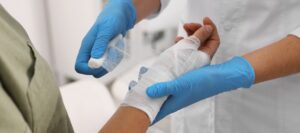 Doctors have been using Botox for a number of years to treat everything from wrinkles to headaches. Botox is a brand name given to a type of toxin produced by the bacterium Clostridium botulinum. Dysport and Xeomin are derived from the same bacterium but marketed under different brand names.
Doctors have been using Botox for a number of years to treat everything from wrinkles to headaches. Botox is a brand name given to a type of toxin produced by the bacterium Clostridium botulinum. Dysport and Xeomin are derived from the same bacterium but marketed under different brand names.
Botox is injected during a quick and easy procedure and is generally pain free. It sounds great but how does it really work?
How Does Botox Work?
Botox works by freezing the nerves to the muscles so that the muscle can’t contract or form a wrinkle. As a result, wrinkles relax and soften. People often use Botox as a preventative to wrinkles because it keeps the face from making certain expressions that eventually cause permanent creases, or wrinkles, to form.
Your muscles contract because your nerves release a chemical signal instructing them to do so; this chemical is known as acetylcholine. More specifically acetylcholine is a neurotransmitter that can be found where nerve endings and muscle cells meet. Botox injections inhibit the release of acetylcholine, preventing the signal for muscle contraction from sending out in the first place.
(Learn More)
A very fine needle is used to inject Botox into specific muscles. Botox can be injected without any anesthesia in as little as a few minutes causing at most slight pressure and minimal discomfort. Any swelling that arises will go down within several days to one week so that you look good as new.
Botox is most often used to treat wrinkles and fine lines on the forehead, around the eyes (crow’s feet), and frown lines. Not all wrinkles can be treated with Botox, for instance wrinkles that are caused by sun damage or gravity are not treatable with Botox.
Botox is also used to fill in lips, cheekbones, neck or corners of the mouth. Botox is truly an art form and when properly applied can rejuvenate your look without invasive surgery.
Botox is approved for both medical and cosmetic uses, including:
-Crow’s feet lines (around the eyes)
-Canthal lines
-Glabellar lines (lines that form between the eyebrows)
-Eyelid spasms (Blepharospasm)
-Neck and shoulder spasms (Idiopathic Rotational Cervical Dystonia)
-Chronic migraines
-Excessive sweating
-Crossed eyes (Strabismus)
-Upper limb spasticity occurring after a stroke
-Overactive bladder
-Detrusor overactivity urinary incontinence
-Hemifacial spasm
How Long Do Botox Injections Last?
Botox is quickly applied and the results are almost instantaneous, but it only offers a temporary solution. Eventually Botox wears off and muscles will regain full range of motion.
In most cases Botox lasts between 4 to 6 months. As the Botox wears off you will notice movement coming back into your muscles, allowing wrinkles and lines to appear again as the muscles relax. At this time injections may be performed again.
Botox Side Effects
The most common side effect of Botox is temporary bruising which should subside within only a few days. Some people experience headaches lasting 24-48 hours after injections, but this side effect is very rare. Another rare but potential side effect is eyelid drooping, which usually disappears three weeks after injections. Drooping is most common if Botox has the chance to move around, which is why it’s important to lie down and relax after injections and avoid rubbing treated areas for at least 12 hours.
(Cosmetic Botox)
Is Botox Dangerous?
6 million Americans get Botox every year, along with 75% of celebrities over 35. Botox has been used by doctors for years and is proven both safe and effective. That being said, Botulinum toxin is incredibly poisonous and deadly. Botox is composed of the same deadly toxin responsible for botulism poisoning, which causes respiratory failure and paralysis. A single gram could kill up to one million people and a couple of kilos could decimate every human on planet earth.
It might seem surprising then that so many people are signing up for Botox, but that’s because it is only poisonous if one has too large a dose. In small amounts Botulinum toxin can safely be injected into humans in order to temporarily paralyze certain muscles. Botox injections include only 1/5 of the estimated dose needed to turn lethal. (Reference)
Interestingly, Botulinum toxin can be found naturally in forests, cultivated soils, lakes, streams, as well as coastal and untreated waters. It can also be found living in the intestinal tracts of mammals and fish. Shellfish and crab carry the bacterium in their gills and viscera.
There are only a few groups of people that are advised against getting Botox. This includes those that are pregnant, breastfeeding or suffer from a neurological disease. If any of these risk factors apply to you, talk to your doctor before deciding on Botox.
To reduce associated risks you should stop taking any anti-inflammatory medications for two weeks and stop drinking alcohol for at least one week prior to getting Botox.
If you are interested in getting Botox injections contact Urgent Medical Center today for more information.





